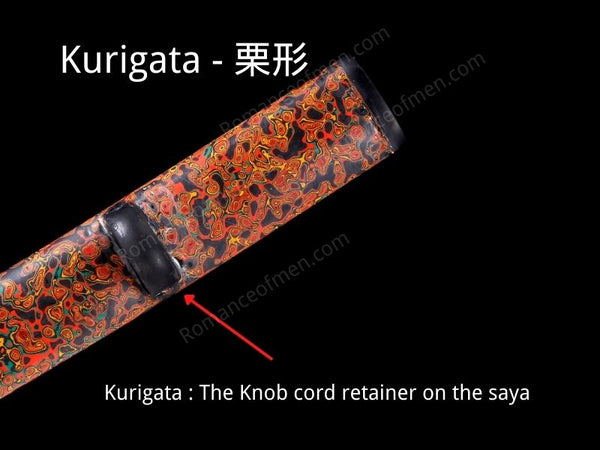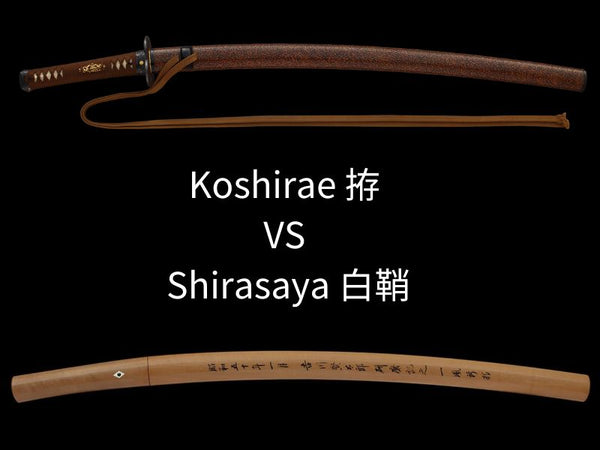Kurigata a "Chestnut" that connects your katana with your obi
Everything You Need To Know About Kurigata
Kurigata is a small knob in the scabbard of a katana. From tying the katana to the belt to balancing the sword, a Kurigata can serve multiple purposes. Before buying a Katana, learning more about Kurigata can be very useful.
Table of Content
- What Is Kurigata?
- What’s The Usage Of Kurigata?
- What Are The Common Materials Of Kurigata?
- Kurigata Making Process
- Common Problems with Kurigata
What Is Kurigata?

Kurigata is the knob used to tie sageo in the scabbard (Saya). Kurigata in Japanese is "栗形", it means "Shape of chestnut" because it resembles a chestnut cut in half. Kurigata is located near the Koiguchi 鯉口, in the front side (表) of the saya.
Note that only saya of Koshirae (拵) has kurigata, because Koshirae is used for carrying the katana. Shirasaya (白鞘) has no kurigata because it's used to store the sword.

A Kurigata allows the wielder to tie the katana with the belt. Material for Kurigata is usually horn or wood, some Kurigata features two tiny metal ring called shitodome “鵐目“ to enhance its decorative value.
What’s The Usage Of Kurigata?

Image source: Ameblo.jp
A kurigata in a katana can serve several purposes:
1- Tie the Sageo: The primary purpose of a Kurigata is to tie the katana to the belt. So, when a samurai ties their sword to their belt, a Kurigata prevents it from falling backward. Especially during long travels or horse riding, tying the katana securely with the belt is essential. A Kurigata aims to keep the katana secured with the Obi belt.
2- Prevent Slipping : Another role of the kurigata is to act as a stopper to prevent the saya from easily slipping out of the belt. As the saya tends to slide down while moving, without the kurigata, it would eventually slip down completely.
Additionally, a Kurigata also helps with Sayabiki (鞘引き), which is when the samurai draws their sword out swiftly in a cutting motion. The user can have better support to operate the katana with a Kurigata. Kurigata mostly holds the sageo. But it also provides a place for thumb support, allows better balance, provides secured tying with Obi, and so on.
When there is a Kurigata, the user can pop-free the sword simply by squeezing the saya. It is an interesting way to draw the katana out for many martial art practices and related events.
What Are The Common Materials Of Kurigata?
Most common material for Kurigata is wood, resin is also widely used in modern days, for more high end swords, buffalo horns and metal are used as well.

Image source: asahitoken.jp
Kurigata were often made from the same wood as the saya, which is magnolia wood "朴木" However, the artisans continue to create them from various materials. This includes materials such as steel, silver, and alloyed metals. These materials are then embellished with carvings, inlays, and painting work, among other things. As a result, the materials of Kurigata will be heavily reliant on the Katana and its scabbard.
In our custom katana section, Kurigata are matched with the saya design.
Kurigata position in the saya
The position of the kurigata on the saya is traditionally determined by various factors including the presence of accessories such as the kozuka (小柄) and kogai (笄). Typically, when a saya has both slots for these accessories, known as "two closet" (両櫃), the kurigata is placed about four finger widths from the koiguchi (鯉口). This spacing is due to the need to accommodate the space for the kogai to fit within the saya.
Even in cases where the sword does not have a kozuka or kogai, this traditional placement is often maintained. However, for swords that doesn't follow this standard—such as those with only one slot (片櫃) or no slots (櫃の無い) for these accessories—the position of the kurigata may vary. Adjusting the kurigata's position might also be desired for reasons related to replicating historical swords or adhering to the requirements of specific martial arts schools, which might dictate a placement as specific as three finger widths from the koiguchi.
Being able to adjust the position of the kurigata thus allows for a degree of customization and adaptation to various styles and functional requirements.
Kurigata Making Process

Image source: Ameblo.jp 拵師
The process of making a kurigata, take buffalo horn plate as example, involves several steps:
Measuring and Drawing: Measure the size of the groove for the kurigata on the saya and roughly sketch the desired shape on the buffalo horn plate. The bottom edge of the sketch corresponds to the length of the groove on the saya. This description focuses on making a square-shaped kurigata.
Drilling the Cord Hole: Drill a hole for the cord at the designated spot.
Cutting Out the Shape: After drilling the hole, use a saw to cut out the surrounding area. This step can be done using different methods, such as an electric jigsaw.
Sanding: Next, sand the outer perimeter using a sander or similar tool. During this process, the bottom side is made thicker while the top side is thinner, with a recommended difference of about 2 mm between the top and bottom. However, the final product should have a suitable thickness difference.
Groove Carving for the Saya: When carving the groove for the kurigata on the saya, carve the sides of the groove wider towards the bottom. This method allows the kurigata to be fitted from the side rather than from the top, ensuring it cannot be pulled out upwards. If the existing groove in the saya is vertical, either keep the thickness of the buffalo horn kurigata uniform or re-carve the groove in the saya.
Final Shaping and Polishing: Lastly, shape the exterior and the hole with a file to finish. Polishing the completed kurigata with fine sandpaper or similar will bring out a shine in the kurigata.
Common Problems with Kurigata
Kurigata getting loose:
If your kurigata becomes loose, don't worry! Since it was originally attached with glue, you can easily fix it by reapplying some glue to secure it back in place. Just a bit of glue should do the trick to make it tight and secure again.
Conclusion
For sword enthusiasts and Katana collectors, a Kurigata is of great importance. From balancing to securely tying a sword with the belt, Kurigata has various uses in the Katana. So, make sure to carefully go through the Kurigata when you get your Katana. We appreciate you stopping by! Don't forget to check our katana anatomy for more info.





















